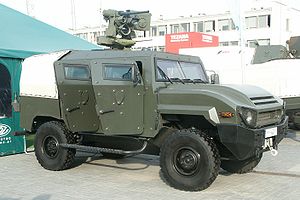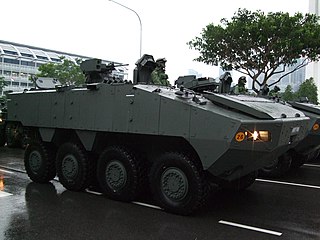
The Terrex Infantry Carrier Vehicle (ICV) is an armoured fighting vehicle (AFV) developed by ST Engineering of Singapore and Timoney Technology of Ireland, and produced by ST Engineering Land Systems for the Singapore Army as well as by Turkish auto-maker Otokar as the Yavuz (AV-82) for the Turkish military.

The Mowag Eagle is a series of wheeled armoured vehicle designed by Mowag, a Swiss company now owned by GDELS.

An infantry mobility vehicle (IMV) is a four-wheel drive armored personnel carrier (APC) serving as an armed military transport, military patrol, reconnaissance or security vehicle. Those IMVs are distinct from 8-, 6-, and 4-wheeled APCs, being closer in appearance to civilian vehicles. The physical appearance of the Infantry mobility vehicles are generally similar to the SUV, covered Pickup truck or Box truck. Examples include the ATF Dingo, Otokar Cobra II, Iveco LMV, AMZ Dzik, AMZ Tur, Mungo ESK, and Bushmaster. Most modern infantry mobility vehicles have certain level of Mine-Resistant Ambush Protected (MRAP) capabilities.

Dzik is a 4.5-tonne Polish-made multi-purpose infantry mobility vehicle. Produced by the AMZ works in Kutno, it is designed for serving both the patrol and intervention roles, as well as an armoured personnel carrier for use by various peace-keeping and policing forces. Its armour provides defence against 7.62 mm bullets. The Dzik-3 also boasts bulletproof windows, puncture-proof tires and smoke launchers.
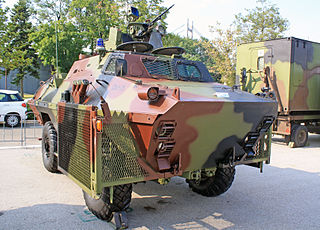
The BOV, is an all-wheel drive armoured vehicle manufactured in the former Yugoslavia and today in Serbia. The second generation BOV is currently in development.

The AMZ Żubr is an infantry mobility vehicle produced by AMZ-Kutno which is used by the Polish military. "Żubr" is also the Polish word for wisent. It was designed by AMZ-Kutno and began production in 2008.
AMZ Kutno is an automotive company based in Kutno, Poland, that has been operating since 1999. It specializes in the design and manufacture of special bodies for commercial vehicles, such as minibuses, ambulances, security vans and special vehicles for the uniformed services. The company also produces a line of city buses and various military vehicles.
Otokar Arma is a 6x6 and 8x8 amphibious wheeled armored combat vehicle family designed and developed by Otokar. The vehicle is a modular multi-wheel configurable with a monocoque steel hull.
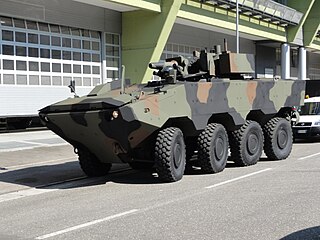
The Iveco SuperAV is an eight-wheel drive tactical vehicle developed by the Italian commercial vehicle company Iveco. A version made in collaboration with BAE Systems was selected by the United States Marine Corps for the Amphibious Combat Vehicle program.

The Tigr is a Russian 4×4 multipurpose all-terrain infantry mobility vehicle manufactured by Military Industrial Company, first delivered to the Russian Army in 2006.

Tulpar is a Turkish heavy infantry fighting vehicle designed by the Sakarya-based automotive manufacturer Otokar. It is named after the Tulpar, a winged horse in Turkic mythology.
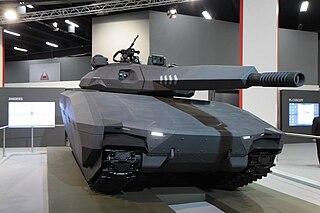
The PL-01 was a Polish light tank concept created by OBRUM with support from BAE Systems, based on the Swedish CV90120-T light tank. The concept vehicle was first unveiled at the International Defence Industry Exhibition in Kielce on 2 September 2013, but the project was scrapped in 2015.

KamAZ Typhoon is a family of Russian multi-functional, modular, armored Mine-Resistant Ambush Protected Vehicles manufactured by the Russian truck builder KAMAZ. The Typhoon family is part of Russia's Typhoon program. As of 2021, the number of Typhoons in the Russian Armed Forces fleet was about 330 units of Typhoon-K.

Typhoon is a Russian family of Mine-Resistant Ambush Protected (MRAP) armored fighting vehicles (AFVs) in service since 2014. Around 120 Russian companies including KamAZ, Gaz-Group, and Bauman University, etc. are taking part in Typhoon program. The main aim of the program is to design a unified platform for all Russian armored wheeled vehicles.

Eitan is an armoured fighting vehicle (AFV) developed by the Merkava and Armoured Vehicles Directorate in the IMOD to replace the ageing M113 armoured personnel carrier in use by the Israel Defense Forces. Its armored personnel carrier (APC) variant lacks the Iron Fist APS, due to the fact those are not the serial production Eitan vehicles yet. The infantry fighting vehicle (IFV) variant is still not in service.

The Mildef Tarantula HMAV is a Malaysian 4×4 V-hull mine-resistant infantry mobility vehicle that provides high level protection against a variety of battlefield threats such as mines and improvised explosive devices. The vehicle was designed and manufactured by Mildef International Technologies alongside Science Technology Research Institute for Defense (STRIDE) and the Malaysian Armed Forces. It was launched on 11 February 2021.

The AMZBóbr-3 is a Polish wheeled amphibious armoured reconnaissance vehicle. This vehicle is part of a larger effort to replace the aging BRDM-2 armoured reconnaissance vehicles with more advanced platforms under the new Lekkiego Opancerzonego Transportera Rozpoznawczego (LOTR) 'Light Armoured Reconnaissance Transporter' program code-named Kleszcz (Tick).

LPU Wirus 4 is a Light Strike Vehicle, currently used in the Polish Armed Forces and developed by Concept and Polski Holding Obronny. The vehicle can be used in long-range reconnaissance missions and fast strikes.

The Waran is a medium-class wheeled, tactical armored multi-purpose vehicle manufactured by the Polish firm, Huta Stalowa Wola.

Heron – wheeled armoured personnel carrier with a 6x6 drive, in a command vehicle version equipped with HMS C3IS Jasmin data processing and internal communications equipment. The carrier is planned to be used as a command and staff vehicle in Homar-K missile launcher divisions. In May 2024, it was tested in Polish Army exercises under the codename Field Experimentation Exercise 2024, at the Land Forces Training Center in Nowa Dęba and at the training ground in Lipa.
